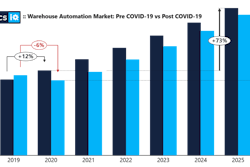
In 1966, an advertisement in the American Philatelist magazine was the first to refer to Black Friday in print, and within the next few decades, the term became the accepted name for the important retail day following Thanksgiving. Consumers are known to rush shops to start their holiday shopping to find the best deals, while stores slash prices hoping to compete with others doing the same. But, since the 1960s, Black Friday looks significantly different, however the concept remains largely the same.
The Amazon Effect is a term heard so often today regarding retail and supply chains because it is that influential. Consumers are now accustomed to getting goods and services within 1-2 days at lower prices thanks to Amazon’s e-commerce model. But, Amazon Prime Day takes that to another level.
For the year 2020, the holiday shopping season changes even more. The Coronavirus disease (COVID-19) is putting pressure on consumers to start shopping earlier in fear of shipping delays, but Walmart and Target have joined Amazon in the creation of their own branded shopping holidays. These companies are not waiting until Black Friday or Cyber Monday to get consumers shopping online, with the hopes of making up for lost revenue caused from COVID-19.
They want to shine in the spotlight on their own day, urging consumers to flock to their sites for 1-2 days for the best deals. But, what pressure will this put on an already stressed supply chains during a worldwide pandemic?
“While Amazon’s October announcement definitely jump-started the promotion trends across other retailers like Walmart and Target this week, most brands are just trying to catch up on the missed revenue from low inventory or low foot traffic during the height of the pandemic,” says Randy Mercer, vice president of global product management at 1WorldSync. “Now, brands are working to kick supply chains into high gear to meet regular demand and to debut holiday offerings ahead of schedule.
“Instead of waiting for Black Friday to announce new lines and Christmas deals, brands are finding that it may be easier to elongate the holiday season, creating a slightly more steady trickle of holiday shopping instead of a fast-paced peak in late November and December," adds Mercer. "Delivery networks like FedEx and UPS have been saturated with demand, so a wider holiday window gives supply chain networks more time to recoup and get back to normal operations.”
Christmas shopping this year will look much different than in years past, as social distancing pushes constraints on the number of customers in a store at a time and driving many to shop online.
“Due to the pandemic, in-store isn’t a viable primary point of sale this year,” says Christine Barnhart, director of go-to-marketing strategy and execution for supply chain at Infor. “The industry is at a turning point where it needs to default to online sales with brick-and-mortar as the secondary. I think we’ll see this as the start of a long-lasting pattern. Shoppers aren’t turning to online just because of shutdowns, but because shopping habits and shopping experiences have changed. With shoppers going online, retailers have the visibility needed to address supply shortages sooner, thanks to more precise demand planning and forecasting. Investments in sense and respond technologies are also paying dividends as retailers can share their needs in real-time with suppliers and gain agility and flexibility.”
These are all factors that put pressure on a supply chain that currently operates under the “New Normal,” and the unknowns that exist due to COVID-19 make it more difficult.
“Prime Day and holiday shopping will have an impact on supply chain as it does every year,” says Mercer. “However, this year is going up against several unknowns. This year there’s going to be an impact that we foresee because of the variables COVID creates, but can’t be anticipated. For example, truck drivers could become ill and be pulled out of commission mid-route, ultimately causing stores to get shipments late and delaying everything. Meanwhile more retailers are acting as micro fulfillment centers. Whereas Amazon has the warehouses, protocol and infrastructure in place these retailers don’t so it’s easier to control these factors in standard fulfillment.”
Advancement of technology helps keep a semblance of normalcy during this unprecedented pandemic and has helped keep many avenues of business running, including the supply chain. For those that can, many companies have had personnel working from home. But automation and digitization also helps take the burden off of human workers and optimizes the field.
“Supply chain managers are facing pressures like never before and, ultimately, are forced to digitize and optimize their processes to accurately predict inventory, demand and supply,” says Barnhart. “Luckily, they can do this by investing in best-of-breed supply chain tools that support plan, execute, sense and respond in real-time on a network platform. Cloud-based data automation, visibility and analytics solutions strip away the need to take calculated risks by shining a light on the supply chain, removing complexity and providing collaboration and optimization. This added agility can take days – and even weeks – off delivery, reduce surprises, allow swift forecast execution and enable supplier orchestration. So, while I think we’re not entirely out of the woods on shortages and wavering demand, I do think we’re at the dawn of a new era of supply chain technology investment, digitization and innovation.”
What will help the U.S. supply chain and retailers is that shipping from China has bounced back. In the early days of COVID-19 when China was severely impacted by the virus, shipping from the country was virtually at a standstill. Luckily, leading into the holiday season, China’s shipments remain moving.
“Inbound shipping from China seems to have rebounded after significant challenges when the coronavirus started,” says Keith Daniels, partner at Carl Marks Advisors. “By spreading the selling season over a period of time, it puts less pressure on the supply chain by spreading things out and may in some cases allow companies to react to items that become high in demand by starting the replenishment process earlier. Where things will get tight in the supply chain is in the final mile, as delivery to the consumer sees increased volume of deliveries.”
These special holiday shopping holidays may put more pressure on the supply chain, but the fact that these retailers are stretching out the holiday season helps everyone out in the long run. Black Friday may look different this year, but the holiday shopping cheer will remain intact.



















